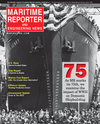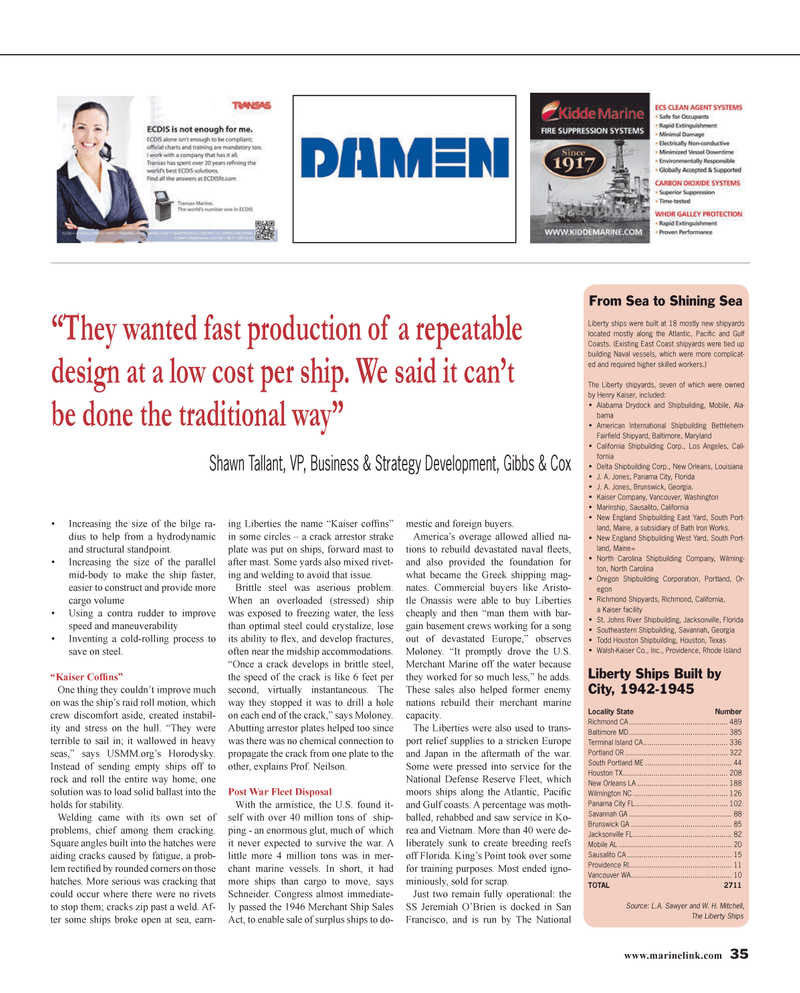
Page 35: of Maritime Reporter Magazine (January 2014)
Ship Repair & Conversion Edition
Read this page in Pdf, Flash or Html5 edition of January 2014 Maritime Reporter Magazine
www.marinelink.com 35 • Increasing the size of the bilge ra- dius to help from a hydrodynamic and structural standpoint. • Increasing the size of the parallel mid-body to make the ship faster, easier to construct and provide more cargo volume • Using a contra rudder to improve speed and maneuverability • Inventing a cold-rolling process to save on steel. “Kaiser Coffi ns”
One thing they couldn’t improve much on was the ship’s raid roll motion, which crew discomfort aside, created instabil- ity and stress on the hull. “They were terrible to sail in; it wallowed in heavy seas,” says USMM.org’s Horodysky.
Instead of sending empty ships off to rock and roll the entire way home, one solution was to load solid ballast into the holds for stability.
Welding came with its own set of problems, chief among them cracking.
Square angles built into the hatches were aiding cracks caused by fatigue, a prob- lem rectifi ed by rounded corners on those hatches. More serious was cracking that could occur where there were no rivets to stop them; cracks zip past a weld. Af- ter some ships broke open at sea, earn- ing Liberties the name “Kaiser coffi ns” in some circles – a crack arrestor strake plate was put on ships, forward mast to after mast. Some yards also mixed rivet- ing and welding to avoid that issue.
Brittle steel was aserious problem.
When an overloaded (stressed) ship was exposed to freezing water, the less than optimal steel could crystalize, lose its ability to fl ex, and develop fractures, often near the midship accommodations. “Once a crack develops in brittle steel, the speed of the crack is like 6 feet per second, virtually instantaneous. The way they stopped it was to drill a hole on each end of the crack,” says Moloney.
Abutting arrestor plates helped too since was there was no chemical connection to propagate the crack from one plate to the other, explains Prof. Neilson.
Post War Fleet Disposal
With the armistice, the U.S. found it- self with over 40 million tons of ship- ping - an enormous glut, much of which it never expected to survive the war. A little more 4 million tons was in mer- chant marine vessels. In short, it had more ships than cargo to move, says
Schneider. Congress almost immediate- ly passed the 1946 Merchant Ship Sales
Act, to enable sale of surplus ships to do- mestic and foreign buyers.
America’s overage allowed allied na- tions to rebuild devastated naval fl eets, and also provided the foundation for what became the Greek shipping mag- nates. Commercial buyers like Aristo- tle Onassis were able to buy Liberties cheaply and then “man them with bar- gain basement crews working for a song out of devastated Europe,” observes
Moloney. “It promptly drove the U.S.
Merchant Marine off the water because they worked for so much less,” he adds.
These sales also helped former enemy nations rebuild their merchant marine capacity.
The Liberties were also used to trans- port relief supplies to a stricken Europe and Japan in the aftermath of the war.
Some were pressed into service for the
National Defense Reserve Fleet, which moors ships along the Atlantic, Pacifi c and Gulf coasts. A percentage was moth- balled, rehabbed and saw service in Ko- rea and Vietnam. More than 40 were de- liberately sunk to create breeding reefs off Florida. King’s Point took over some for training purposes. Most ended igno- miniously, sold for scrap.
Just two remain fully operational: the
SS Jeremiah O’Brien is docked in San
Francisco, and is run by The National
From Sea to Shining Sea
Liberty ships were built at 18 mostly new shipyards located mostly along the Atlantic, Pacifi c and Gulf
Coasts. (Existing East Coast shipyards were tied up building Naval vessels, which were more complicat- ed and required higher skilled workers.)
The Liberty shipyards, seven of which were owned by Henry Kaiser, included: • Alabama Drydock and Shipbuilding, Mobile, Ala- bama • American International Shipbuilding Bethlehem-
Fairfi eld Shipyard, Baltimore, Maryland • California Shipbuilding Corp., Los Angeles, Cali- fornia • Delta Shipbuilding Corp., New Orleans, Louisiana • J. A. Jones, Panama City, Florida • J. A. Jones, Brunswick, Georgia. • Kaiser Company, Vancouver, Washington • Marinship, Sausalito, California • New England Shipbuilding East Yard, South Port- land, Maine, a subsidiary of Bath Iron Works. • New England Shipbuilding West Yard, South Port- land, Maine= • North Carolina Shipbuilding Company, Wilming- ton, North Carolina • Oregon Shipbuilding Corporation, Portland, Or- egon • Richmond Shipyards, Richmond, California, a Kaiser facility • St. Johns River Shipbuilding, Jacksonville, Florida • Southeastern Shipbuilding, Savannah, Georgia • Todd Houston Shipbuilding, Houston, Texas • Walsh-Kaiser Co., Inc., Providence, Rhode Island
Liberty Ships Built by
City, 1942-1945
Locality State Number
Richmond CA ................................................489
Baltimore MD ................................................385
Terminal Island CA ......................................... 336
Portland OR ..................................................322
South Portland ME ..........................................44
Houston TX ...................................................208
New Orleans LA ............................................188
Wilmington NC ..............................................126
Panama City FL .............................................102
Savannah GA ..................................................88
Brunswick GA .................................................85
Jacksonville FL ................................................82
Mobile AL .......................................................20
Sausalito CA ................................................... 15
Providence RI .................................................. 11
Vancouver WA .................................................10
TOTAL 2711
Source: L.A. Sawyer and W. H. Mitchell,
The Liberty Ships “They wanted fast production of a repeatable design at a low cost per ship. We said it can’t be done the traditional way”
Shawn Tallant, VP, Business & Strategy Development, Gibbs & Cox
MR #1 (32-41).indd 35 1/9/2014 9:35:55 AM

 34
34

 36
36
